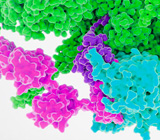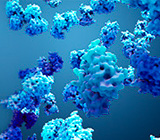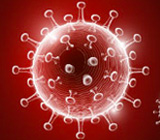-
REAGENT SERVICES
Hot!
-
Most Popular Services
-
Molecular Biology
-
Recombinant Antibody/Protein
-
Reagent Antibody
-
CRISPR Gene Editing
-
DNA Mutant Library
-
IVT RNA and LNP Formulations
-
Oligo Synthesis
-
Peptides
-
Cell Engineering
-
- CRISPR/Cas9 sgRNA
- CRISPR/Cas12a crRNA
- Prime Editing Guide RNA
- Base Editing Guide RNA
- HDR Templates
- gRNA + HDR Template Design Tools
- cGMP Guide RNA
- cGMP HDR Templates
- CRISPR/Cas Proteins
- CAR-T Knock-in Optimization Kit
- CRISPR Plasmids
- CRISPR gRNA Plasmid Libraries
- CRISPR Cell Lines
- Microbial Genome Editing
-
-
PRODUCTS
-
Most Popular Reagents
-
 Instruments
Instruments
-
Antibodies
-
ELISA Kits
-
Protein Electrophoresis and Blotting
-
Protein and Antibody Purification
-
Recombinant Proteins
-
Molecular Biology
-
Stable Cell Lines
-
Cell Isolation and Activation
-
 IVD Raw Materials
IVD Raw Materials
-
 Therapy Applications
Therapy Applications
-
Resources
-
- Pharmacokinetics and Immunogenecity ELISA Kits
- Viral Titration QC ELISA Kits
- -- Lentivirus Titer p24 ELISA KitHot!
- -- MuLV Titer p30 ELISA KitNew!
- -- AAV2 and AAVX Titer Capsid ELISA Kits
- Impurity Test ELISA Kits
- -- BSA ELISA Kit, 2G
- -- Cas9 ELISA KitNew!
- -- Protein A ELISA KitNew!
- -- His tagged protein detection & purification
- -- dsRNA ELISA Kit
- -- Endonuclease ELISA Kit
- COVID-19 Detection cPass™ Technology Kits
-
- Automated Maxi-Plasmid PurificationHot!
- Automated Mini-Plasmid PurificationNew!
- PCR Reagents
- S.marcescens Nuclease Benz-Neburase™
- DNA Assembly GenBuilder™
- Cas9 / Cas12a / Cas13a Nucleases
- Base and Prime Editing Nucleases
- GMP Cas9 Nucleases
- CRISPR sgRNA Synthesis
- HDR Knock-in Template
- CRISPR Gene Editing Kits and Antibodies
-
![AmMag™ Quatro Automated Plasmid Purification]() AmMag™ Quatro automated plasmid purification
AmMag™ Quatro automated plasmid purification
-
![Anti-Camelid VHH]() MonoRab™ Anti-VHH Antibodies
MonoRab™ Anti-VHH Antibodies
-
![ELISA Kits]() ELISA Kits
ELISA Kits
-
![Precast Gels]() SurePAGE™ Precast Gels
SurePAGE™ Precast Gels
-
![Quatro ProAb Automated Protein and Antibody Purification System]() AmMag™ Quatro ProAb Automated Protein and Antibody Purification System
AmMag™ Quatro ProAb Automated Protein and Antibody Purification System
-
![Target Proteins]() Target Proteins
Target Proteins
-
![AmMag™ Quatro Automated Plasmid Purification]() AmMag™ Quatro automated plasmid purification
AmMag™ Quatro automated plasmid purification
-
![Stable Cell Lines]() Stable Cell Lines
Stable Cell Lines
-
![Cell Isolation and Activation]() Cell Isolation and Activation
Cell Isolation and Activation
-
 IVD Raw Materials
IVD Raw Materials
-
![Quick
Order]() Quick Order
Quick Order
-
![Quick
Order]() Quick Order
Quick Order
- APPLICATIONS
- RESOURCES
- ABOUT US
- SIGN IN My Account SIGN OUT
- REGISTER

![Amino Acid Code Amino Acid Code]()
Biology Terms Dictionary
This Biology terms dictionary provides query services for biology and biochemistry terms. Please enter the biology or biochemistry terms you want to search.
List by Alphabet: A B C D E F G H I J K L M N O P Q R S T U V W X Y Z
Biological Enzymes
Introduction
Biological enzymes are highly specialized proteins that catalyze biochemical reactions essential to life. These enzymes increase reaction rates by lowering the activation energy required for specific processes, allowing cells to maintain metabolism, replication, and repair under physiological conditions. Enzymes are crucial in various fields, including medicine, agriculture, food processing, and biotechnology. They exhibit remarkable substrate specificity, and many are regulated through feedback mechanisms or environmental factors such as temperature and pH. Some enzymes also require cofactors, like metal ions or coenzymes, to function optimally.
Mechanisms of Enzyme Activity
The activity of enzymes follows a sequence of events that ensure efficient catalysis of specific biochemical reactions. The following are the key mechanisms involved in enzyme action:
- Enzyme-Substrate Binding
Enzymes contain an active site—a specific region where the substrate binds. The binding may follow:- Lock-and-key model: The substrate fits precisely into the enzyme's active site.
- Induced fit model: The enzyme undergoes conformational changes to fit the substrate better upon binding.
- Formation of the Enzyme-Substrate Complex
When the substrate binds to the active site, an enzyme-substrate complex is formed. This complex lowers the activation energy required for the reaction to proceed by stabilizing the transition state. - Catalysis and Product Formation
The enzyme catalyzes the conversion of the substrate into products through a series of steps that involve bond breaking and formation. During catalysis, some enzymes use acid-base catalysis or covalent catalysis to facilitate the reaction. - Product Release
Once the reaction is complete, the products are released from the active site. The enzyme remains unchanged and is free to catalyze subsequent reactions. - Cofactors and Enzyme Activation
Many enzymes require non-protein components known as cofactors (e.g., metal ions like Mg²⁺) or coenzymes (e.g., NAD⁺, FAD) to achieve full catalytic activity. Some enzymes also rely on post-translational modifications (e.g., phosphorylation) for activation.
Applications of Biological Enzymes
- Medical and Pharmaceutical Applications
- Diagnostic Enzymes: Enzymes such as glucose oxidase are used in glucose meters to monitor blood sugar levels.
- Enzyme Replacement Therapy (ERT): Patients with enzyme deficiencies (e.g., Gaucher disease) benefit from recombinant enzymes administered through ERT.
- Drug Metabolism: Cytochrome P450 enzymes are involved in the breakdown of drugs in the liver, influencing pharmacokinetics.
- Food and Beverage Industry
- Amylases and proteases are used in baking to improve dough quality and breakdown proteins.
- Lactase is added to dairy products to help lactose-intolerant consumers digest lactose.
- Pectinase is employed in juice production to enhance clarity and yield.
- Agriculture
- Cellulases and hemicellulases are used to decompose plant material in animal feed, increasing nutrient availability.
- Nitrogenase enzymes are central to nitrogen fixation, improving soil fertility.
- Biotechnology and Industrial Use
- Immobilized enzymes are used in industrial biocatalysis to produce biofuels, chemicals, and pharmaceuticals.
- Enzymes such as lipases and esterases catalyze reactions in organic synthesis for cosmetics and biodiesel production.
- ELISA-based assays leverage enzymes (e.g., horseradish peroxidase) to detect antigens or antibodies in biological samples.
Tools and Services for Enzyme Production and Analysis
- GenScript’s Enzyme Expression and Purification Services: GenScript provides custom recombinant enzyme production using various expression systems tailored for research, industry, and pharmaceuticals.
- BacPower™ Customized Service: GenScript supports low-cost and high-yield production of a broad range of recombinant proteins, such as cytokines, enzymes, immunogens, and antibody fragments.
Challenges and Future Directions
Despite their widespread use, several challenges remain in enzyme production and application. Enzyme stability under extreme conditions (e.g., high temperatures or pH) limits their industrial application. Additionally, enzymes involved in complex metabolic pathways may show allosteric regulation, complicating their use in artificial systems. Future innovations include:
- Protein engineering to improve enzyme stability and catalytic efficiency.
- Directed evolution to generate enzymes with novel functions or improved properties.
- Synthetic biology approaches to design new enzymes tailored to specific industrial or medical applications.
- AI-driven enzyme design to predict and optimize enzyme structures for improved function.
Conclusion
Biological enzymes are indispensable across numerous industries and scientific fields due to their specificity, efficiency, and versatility. While challenges such as stability and regulation persist, advances in protein engineering, synthetic biology, and AI-guided enzyme design offer promising solutions. As enzyme technology continues to evolve, its impact on pharmaceuticals, biotechnology, food production, and environmental applications will only grow, driving innovation across multiple disciplines.
- Tags:
- Protein
Related Biology Tools
-
GenSmart™ Codon Optimization
GenSmart Optimization is a free online tool for performing codon optimization to improve gene expression. GenScript's patented algorithms are integrated into the tool to optimize the computing capability of high-performance sequence generation.
-
DNA Construct Design Tool
GenSmart™ Design is a free online DNA construct design tool developed by GenScript. GenSmart™ Design has two design modules, the Create Construct module for individual plasmid design and the Create Library module for DNA library design.
-
Codon Frequency Tables
This online tool shows commonly used genetic codon frequency table in expression host organisms including Escherichia coli and other common host organisms.
Service and Products

Protein Expression
GenScript recombinant protein and rAb services provide high quality recombinant proteins and rAbs for a variety of downstream research applications.

Bacterial Expression
One-stop service from Sequence to Protein starting from $1600, 4 weeks.

Insect Expression
GenScript's BacuVance baculovirus expression system was developed by our in-house team of scientists for virus production and expression of recombinant proteins from baculovirus-infected insect cells.

Mammalian Transient Expression
Proprietary High Density (HD) expression system, enhance the protein yield up to 100 fold, achieve antibody titers up to 3 g/L.

Reagents for COVID-19 Research
Gram level, ready to ship RBD proteins, ACE2 assay cell lines and pseudovirus.
-
Top Search
-
Hot Glossary
-
Antibody
If you know of any terms that have been omitted from this glossary that you feel would be useful to include, please send detail to the Editorial Office at GenScript: website@genscript.com
If your term is adopted, we will send 1,000 EzCoupon points to your GenScript account.
-





































